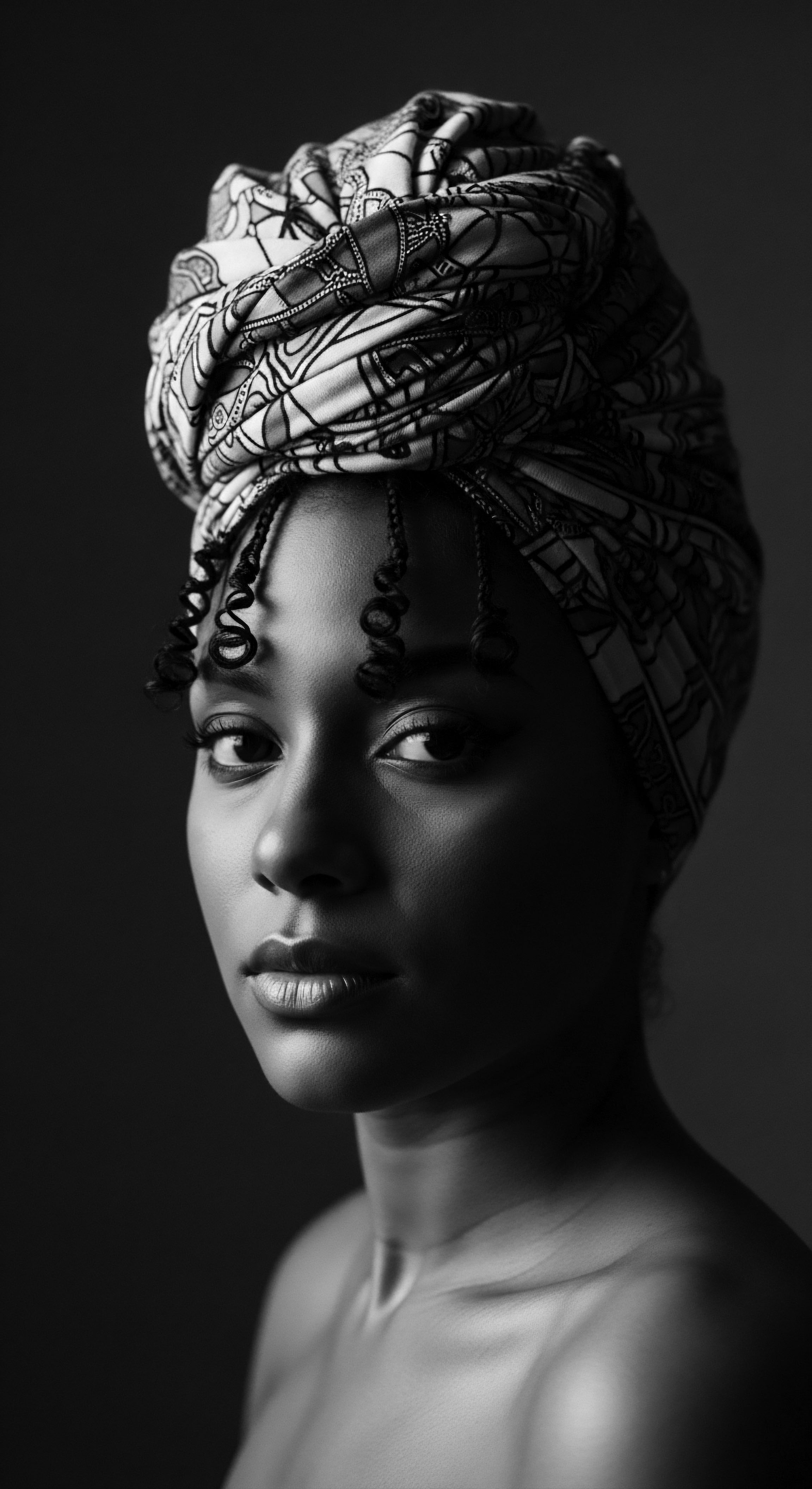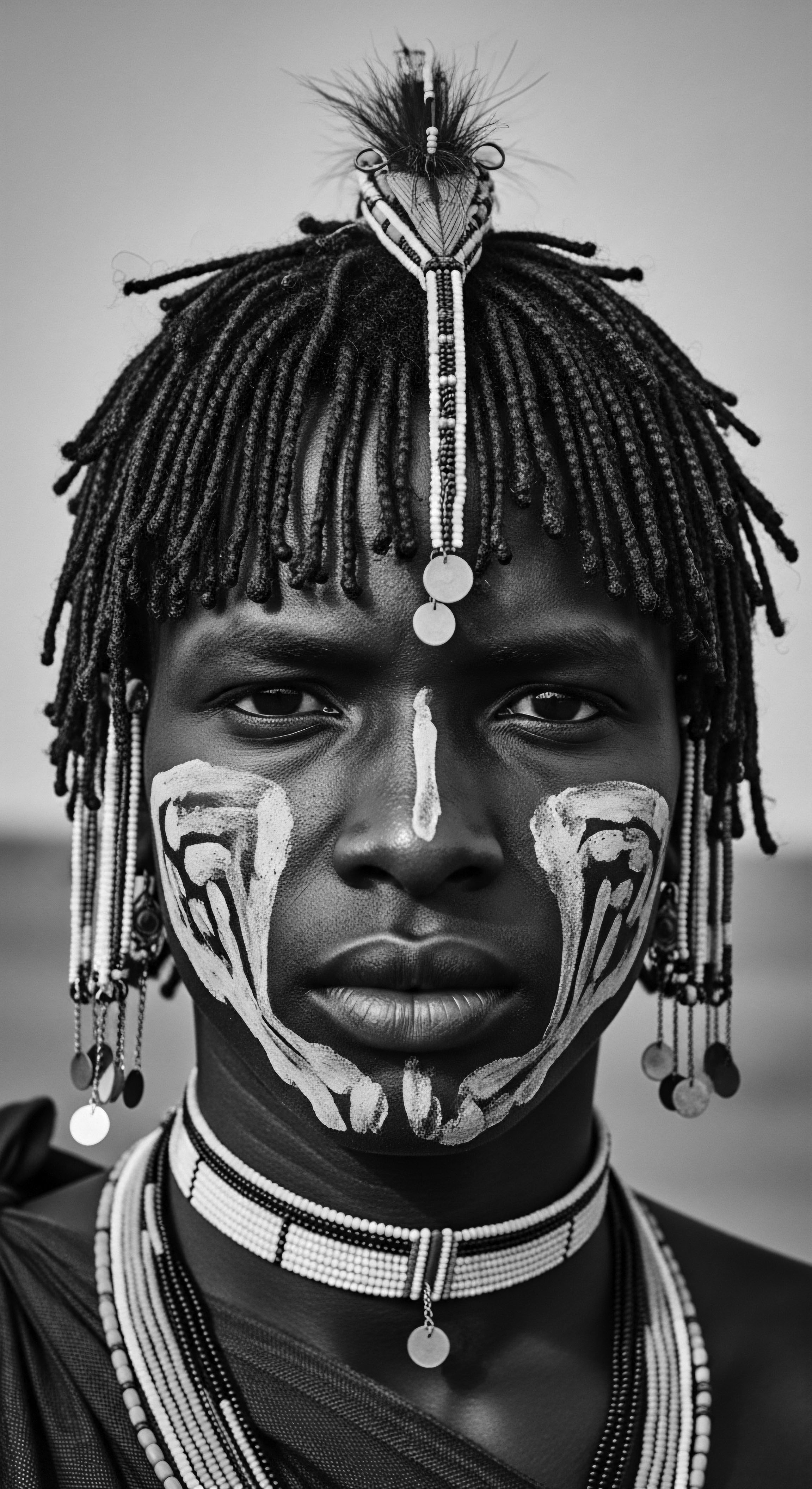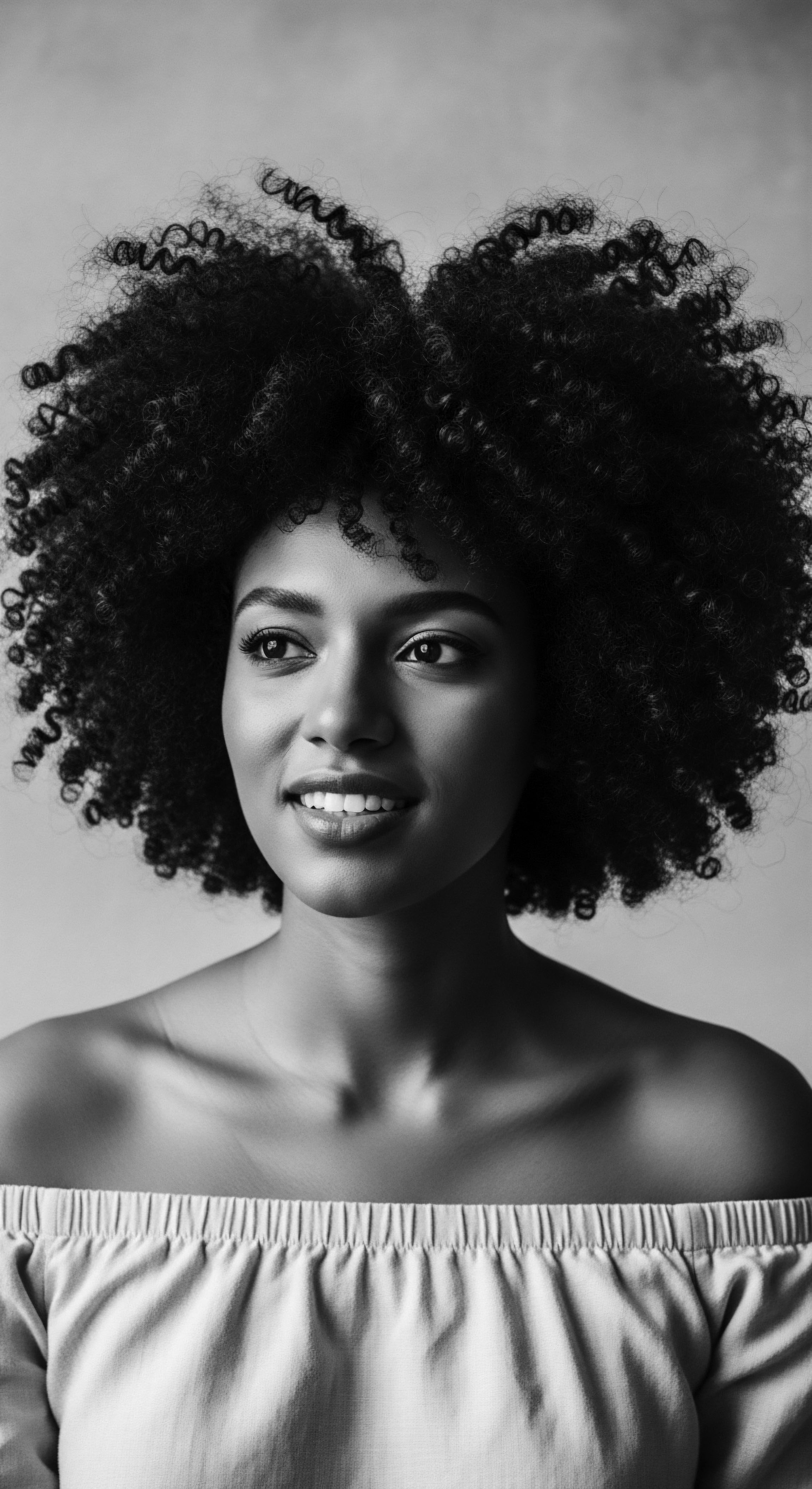
Roots
Consider, for a moment, the whisper of ancient winds through palm fronds, carrying stories of sun-kissed shores and the profound connection between people and the very fibers that crown their heads. For those of us whose hair coils, crimps, or ripples with distinct patterns, this contemplation is more than academic; it is a homecoming. Our strands are not merely biological filaments; they are living archives, each helix a record of journeys, resilience, and the deeply ingrained wisdom of those who came before us.
This is where the enduring legacy of ancient Polynesian hair customs becomes so poignant for modern textured hair care. It offers not prescriptions, but rather a different lens through which to view our own inherited beauty, reminding us that care is a continuation, a respectful nod to the past, and a powerful statement in the present.

Echoes From The Source
The very structure of textured hair – its distinctive elliptical cross-section, its propensity for coiling, the sometimes delicate cuticle layers – presents unique characteristics that demand a specific approach to care. In the humid, salty embrace of the Pacific, where Polynesian peoples cultivated vibrant civilizations for millennia, a profound understanding of hair was born. This understanding was not codified in laboratories, but rather lived, breathed, and passed down through the gentle touch of hands.
They intuitively recognized the hair’s need for hydration, for protection from relentless sun and wind, and for fortification from natural elements. Their methods, honed over generations, reveal a symbiotic relationship with their environment, where the land provided the remedies for healthy, lustrous hair.
Polynesian hair types spanned a range, from straighter waves to more pronounced curls, but the principles of care often unified their approaches. The prevailing climate, with its constant sun and ocean exposure, necessitated regimens focused on moisture retention and scalp health. The ancestral Polynesian world was a vast ocean highway, and the voyages undertaken, often spanning great distances, would have exposed hair to incredible environmental stressors.
The fact that their hair remained a symbol of strength and vitality speaks volumes about the efficacy of their established traditions. These practices, built on observation and experimentation with the gifts of their islands, represent a true ancestral science.

The Hair’s Intrinsic Design And Ancestral Wisdom
Our hair, at its most elemental, is a protein fiber, primarily keratin. However, the specific arrangement of these protein chains and the shape of the follicle determine the hair’s curl pattern. Textured hair often exhibits variations in cuticle scales along its length, which can influence how moisture is absorbed and retained. The ancient Polynesians, without microscopes or chemical analyses, seemed to grasp these very principles through tactile knowledge.
They knew which botanicals provided lubrication, which offered cleansing without stripping, and which provided a shield against the elements. This innate understanding, passed through generations, formed the bedrock of their hair practices.
Ancestral Polynesian hair practices offer a heritage-infused understanding, recognizing hair not merely as biological strands but as vessels of cultural memory.
Consider the simple act of oiling. This was not merely about aesthetic shine. The careful application of rich, indigenous oils, often infused with aromatic plants, served to seal the hair’s outer layer, providing a protective barrier against dehydration and physical stress.
This aligns remarkably with modern understanding of how to manage porosity in textured hair, where sealing moisture within the hair shaft is a primary goal. The wisdom of these island communities was rooted in a deep respect for the hair’s very composition.

Botanical Allies From Ancient Shores
The bounty of the Polynesian islands supplied a natural pharmacy for hair. From the omnipresent coconut palm to the potent kukui nut, these plants were not just sustenance; they were core components of beauty and wellness.
- Coconut Oil ❉ A cornerstone, used widely across the Pacific for its moisturizing and protective qualities. Its molecular structure permits it to penetrate the hair shaft, a benefit modern science now affirms for strengthening hair.
- Kukui Nut Oil ❉ Known for its light texture and ability to condition. It was often employed to add luster and manageability, particularly valuable for detangling denser hair patterns.
- Ti Leaf ❉ Utilized in wraps or infusions, the ti leaf was believed to condition the scalp and promote hair vitality. Its broad surface also made it ideal for temporary protective coverings.
The meticulous preparation of these botanicals—often involving pressing, infusing, or fermenting—reflects a sophisticated empirical process. The knowledge of which plant part to use, when to harvest, and how to process it for maximum benefit was a testament to their deep ecological intelligence. This knowledge, a true inherited treasure, forms the basis for understanding how these rituals can inform our contemporary care.

Ritual
The very word ‘ritual’ conjures images of reverence and purpose, and nowhere is this more apparent than in the ancient Polynesian approach to hair care. Their practices were not isolated acts of vanity; they were integral to daily life, social structure, and spiritual connection. The tender handling of hair became a lived expression of respect for self, family, and lineage. These routines, passed from elder to youth, formed a tender thread connecting generations, solidifying identity through touch and shared wisdom.

The Daily Practice Of Generational Care
Hair care in ancient Polynesia was often a communal affair, particularly among women. It involved regular cleansing, oiling, and styling, sometimes taking hours. This dedicated time was not a chore but a moment of connection, story-sharing, and instruction. Picture a gathering where aunties and grandmothers patiently teach younger hands the precise way to detangle, how to apply oils with intention, or how to braid intricate patterns that held cultural meaning.
This collective wisdom, this passing down of sensory knowledge, forms the very heart of their heritage. The hands-on, community-centered aspect stands in contrast to much of today’s individualized, product-driven routines.

What Did Daily Hair Care Look Like Among Ancient Polynesians?
The rhythm of care was dictated by the elements and the community’s needs. Cleansing was often done with water – fresh spring water or even seawater – often followed by infusions of plant matter. A plant called ‘kalo’ (taro) or ‘noni’ could be used in concoctions for hair and scalp health.
Oiling was a constant, essential practice to shield the hair from the harsh tropical sun and salt air. These natural emollients provided shine, slip for detangling, and a protective barrier.
| Aspect of Care Primary Cleanser |
| Ancient Polynesian Practice Fresh water, plant infusions (e.g. taro), sea water |
| Modern Textured Hair Practice Sulfate-free shampoos, co-washes |
| Aspect of Care Primary Moisturizer/Sealant |
| Ancient Polynesian Practice Cold-pressed oils (e.g. coconut, kukui nut) |
| Modern Textured Hair Practice Natural oils (e.g. shea butter, argan oil), creams, leave-ins |
| Aspect of Care Detangling Method |
| Ancient Polynesian Practice Finger detangling, wide-tooth combs from wood/bone, oils |
| Modern Textured Hair Practice Wide-tooth combs, detangling brushes, conditioners, pre-poos |
| Aspect of Care Protective Styling |
| Ancient Polynesian Practice Braids, buns, intricate updos, ti leaf wraps for sun/sleep |
| Modern Textured Hair Practice Braids, twists, buns, wigs, scarves, bonnets |
| Aspect of Care Holistic Approach |
| Ancient Polynesian Practice Integrated with spiritual health, community bonding, natural environment |
| Modern Textured Hair Practice Often individualistic, focused on product efficacy, growing interest in wellness |
| Aspect of Care The enduring wisdom of ancient approaches continues to shape contemporary practices, particularly within the heritage of textured hair care. |

The Craft Of Hair Adornment
Beyond basic care, hair was a canvas for artistry and a symbol of status, power, and identity. Elaborate hairstyles, often adorned with fresh flowers, fragrant leaves, shells, or intricately carved combs, were common. These styles were not merely decorative; they communicated social standing, marital status, or tribal affiliation.
The practice of using fresh blossoms, like tiare or frangipani, was not only for beauty but also for the natural fragrance they imparted, a subtle luxury in their daily lives. The very act of preparing the hair for such adornments would have been a ritual in itself, a process of careful preening and shaping that speaks to the deep cultural significance of hair.
Polynesian hair rituals were not just about aesthetics; they were profound acts of cultural affirmation, community building, and ecological understanding.
The combs used were often crafted from wood, bone, or turtle shell, each piece a testament to the artisan’s skill. These tools, unlike many modern plastic variants, would have been gentle on the hair, respecting its natural texture and preventing breakage. The emphasis was on working with the hair, not against it, a principle that resonates deeply with the tenets of modern textured hair care.
This gentle approach, coupled with nourishing ingredients, minimized manipulation and breakage, allowing hair to grow strong and long. It is a heritage of kindness to the strand.

Scalp Health And Natural Ingredients
The health of the scalp was paramount, understood as the foundation for vibrant hair. Massages with oils were routine, believed to stimulate blood flow and distribute natural oils. This ancient practice, devoid of harsh chemicals, focused on maintaining a balanced scalp environment, which directly impacts hair growth and strength. Modern science affirms the benefits of scalp massage for circulation and product absorption, echoing this long-held wisdom.
The ingredients chosen were always from their natural surroundings, reinforcing the idea that wellness stems from a respectful connection to one’s environment. The practices underscore that true hair vitality begins at the root, a deeply intuitive and inherited truth.

Relay
The threads of ancestral wisdom, spun across generations, now reach our present moment, offering profound lessons for contemporary textured hair care. This is not about replication, but rather a thoughtful translation of ancient Polynesian principles into our modern context, particularly for those whose heritage links them to coiled and curly hair. The journey of the textured strand, from ancient times to today, is a narrative of resilience, adaptation, and the enduring power of inherited knowledge. How these ancient practices “relay” to our world speaks to hair as a living, dynamic part of identity.

Connecting Ancient Wisdom With Modern Science
The intuitive practices of ancient Polynesia often find remarkable validation in contemporary scientific understanding. Consider the use of coconut oil. For centuries, it was known to Polynesians for its ability to soften and strengthen hair. Recent research has shed light on its unique molecular structure, demonstrating its capacity to penetrate the hair shaft more effectively than many other oils, reducing protein loss during washing.
(Rele and Mohile, 2003) This is a powerful instance where empirical, ancestral knowledge predated and aligns with modern scientific discovery. Such overlaps underscore that traditional methods were not arbitrary; they were born of keen observation and successful application over extended periods.
The principles of gentle care, consistent nourishment, and protective styling, central to Polynesian hair traditions, provide a timeless blueprint for modern textured hair health.
The emphasis on scalp health in Polynesian rituals—through regular massage and herbal applications—also aligns with current dermatological understanding. A healthy scalp environment is fundamental for hair growth and mitigating common issues like dryness or irritation, which are particularly prevalent in textured hair types. The gentle, consistent manipulation inherent in their routines, often through finger detangling or wide-tooth tools, minimized stress on the hair.
This reduces breakage and maintains length, a primary goal for individuals with delicate hair patterns. These are simple, yet profound, relays from ancient shores.

The Enduring Legacy Of Hair As Identity And Heritage
For many Black and mixed-race communities, hair has long served as a powerful marker of identity, cultural pride, and often, a site of struggle against dominant beauty standards. The natural hair movement of recent decades represents a profound reclaiming of self, mirroring, in spirit, the deep cultural significance hair held for Polynesians. Just as Polynesian hairstyles denoted social standing or tribal affiliation, hair in Black diasporic communities has conveyed messages of resistance, spiritual connection, and aesthetic autonomy. The practice of protective styling, so common in Polynesian traditions for practical and aesthetic reasons, finds a direct parallel in the braids, twists, and locs cherished within Black hair culture, serving to safeguard fragile strands and express identity.
An illuminating case study from the early 20th century highlights this connection. During periods of intense cultural suppression, for instance, among some Indigenous communities facing colonial pressures, the care and styling of hair became a quiet act of resistance. While specific to Native American contexts, one can draw parallels to the steadfast preservation of hair traditions among enslaved Africans and their descendants, where hair became a canvas for secret messages, a symbol of freedom, and a tangible link to a stolen heritage. (Tharps and Byrd, 2001, p.
119) The resilience of hair practices, passed down despite immense adversity, speaks to a universal human need to connect with ancestry through tangible, daily acts. Polynesian communities, navigating their own historical currents, maintained their hair customs as integral to their cultural fabric, demonstrating a similar tenacity.

Cultivating A Respectful Connection
The contemporary textured hair journey often involves a re-education, a shedding of externally imposed ideals in favor of self-acceptance and a connection to ancestral practices. The Polynesian way teaches patience and reverence. They did not seek to alter the hair’s natural state but to nourish it within its inherent design. This stands as a powerful counterpoint to historical pressures to chemically straighten or aggressively manipulate textured hair into forms that denied its natural curl.
Modern textured hair care can gain considerable wisdom by observing Polynesian principles:
- Mindful Ingredient Selection ❉ Prioritize natural, minimally processed ingredients, echoing the Polynesian reliance on pure botanical extracts. Seek out oils and butters with properties similar to coconut or kukui.
- Gentle Handling ❉ Adopt practices that minimize friction and manipulation. This includes finger detangling, using smooth tools, and careful protective styling.
- Consistent Hydration ❉ Recognize the constant need for moisture, adapting the concept of daily oiling to modern routines, perhaps through leave-in conditioners and sealing oils.
- Scalp Wellness Focus ❉ Maintain a healthy scalp through regular, gentle cleansing and massage, understanding its foundational role in hair vitality.
- Hair as Identity ❉ Approach hair care not just as maintenance but as an affirmation of personal and cultural identity, a continuation of ancestral narratives.
The relay of wisdom from ancient Polynesian hair rituals is a profound gift. It is a reminder that the path to vibrant, healthy textured hair is often found not in complex new formulations, but in the enduring, patient, and deeply respectful practices that have sustained hair heritage for millennia. It encourages us to look backward to move forward, understanding that the roots of our beauty are as deep and intricate as the human story itself.

Reflection
As the sun dips below the horizon, casting long shadows over the ocean, we pause to consider the journey of the strand. From the elemental biology that shaped its curl to the tender rituals that preserved its vitality, and finally, to the resonant echoes in our modern lives, the exploration of ancient Polynesian hair customs reveals a profound truth. Our hair, particularly our textured hair, is more than a crowning glory; it is a profound connection to the collective human story, a living, breathing archive of our ancestors’ ingenious wisdom and enduring spirit.
The Roothea ethos, “Soul of a Strand,” finds its deepest resonance here. It invites us to view each coil, each wave, as a testament to the legacy carried within us. The patient hands that once pressed coconut oil, the communal spirit that guided shared grooming, the deep respect for natural resources – these are not relics of a bygone era.
They are guiding lights, illuminating a path toward a more holistic, respectful, and affirming relationship with our hair. Our textured hair heritage is a wellspring of knowledge, demonstrating that true beauty stems from reverence for what is inherently ours, a gentle wisdom that continues to shape our present and our future.

References
- Rele, S. & Mohile, R. (2003). Effects of mineral oil, sunflower oil, and coconut oil on prevention of hair damage. Journal of Cosmetic Science, 54(2), 175-192.
- Tharps, L. & Byrd, A. (2001). Hair Story ❉ Untangling the Roots of Black Hair in America. St. Martin’s Press.
- Harding, S. (2012). The Natural Hair Handbook ❉ The Definitive Guide to Natural Hair. Self-published.
- Clarke, K. (2007). The Encyclopedia of Black Hair ❉ A Cultural History. Greenwood Press.
- Cox, J. (2005). Hair and Dress in Ancient Samoa. University of Otago Press.
- Kamehameha Schools. (1993). Native Hawaiian Plant Use. Kamehameha Schools Press.
- Te Rangi Hiroa (Peter H. Buck). (1964). Arts and Crafts of Hawaii. Bishop Museum Press.
